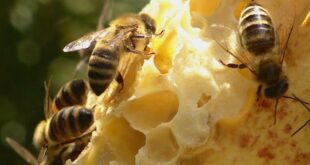As the federal government weighs whether to regulate so-called forever chemicals as toxic, CBC's Marketplace tested popular makeup brands for these chemicals and found measurable levels in three of four brands.
Polyfluoroalkyl substances (PFAS), also known as forever chemicals, are a group of more than 12,000 chemicals used in a variety of products — from makeup to raincoats to non-stick pans to fast-food packaging — to repel things like water, grease and dirt.
Miriam Diamond, an environmental chemist and professor at the University of Toronto, says while these characteristics make PFAS useful in our products, those same traits make PFAS persistent and hard to break down in our bodies and the environment.
"Ninety-nine per cent of Canadians have some level of PFAS in us. That's an astonishing level," said Diamond.
PFAS that have been studied in detail have been linked to a variety of potential health effects, from higher cholesterol levels to increased risk of certain cancers.
- Watch the full Marketplace episode, Chemical Shock: Testing the Makeup of Your Makeup, Friday at 8 p.m., 8:30 p.m. in Newfoundland, on CBC-TV and anytime on CBC Gem or YouTube.
This past summer, the Canadian government released a long-awaited draft report on PFAS and is expected to make a decision about classifying all PFAS as toxic to human health. Health Canada says they will release the final report as "expeditiously" as possible, but didn't specify a date.
Diamond says PFAS can be found in makeup marketed as smudge-proof, long-lasting or waterproof.

To find out to what extent people are being exposed to PFAS through makeup sold in Canada, Marketplace sent foundations, mascaras and eyeliners from Quo, Marcelle, MAC and Burt's Bees for lab testing to see if PFAS were present, identify the type of PFAS in the products and determine how much of the identified PFAS the products contained.
Test results
Products from the four makeup brands were first sent for a pre-screening test run out of Notre Dame University in Indiana by Graham Peaslee, a professor of physics. His machine tests for total fluorine, which is a possible indicator of PFAS.
Based on these results, Marketplace sent makeup products flagged as potentially containing PFAS to Amy Rand, an assistant professor at Carleton University in Ottawa for in-depth testing.
- Got a tip you think Marketplace should investigate? Email us: marketplace@cbc.ca
Rand's lab used two types of tests to determine if any of the 32 most commonly used PFAS in cosmetics were in the products Marketplace sent. For each product tested, Marketplace sent three samples to be analyzed.
The five makeup products that were found to have PFAS in Marketplace's testing are:
- Quo StayPut Eyeshadow in lavender field.
- Marcelle Light Infused Luminous Foundation in nude beige.
- MAC Studio Fix Fluid SPF 15 in NC5.
- Marcelle Liquid Eyeliner in true brown.
- MAC Stack Waterproof Mascara in black.
Three makeup products Marketplace sent for testing did not have measurable levels of the PFAS Rand tested for:
- Burt's Bees Nourishing Mascara in black brown.
- Burt's Bees Good Glows Tinted Moisturizer in chestnut.
- Quo Precision Liquid Liner in jet black.
Diamond says the likely reason Burt's Bees products were flagged in the pre-screen is because they have hectorite and mica — a mineral and clay — which both contain fluorine.
In a statement, Burt's Bees said it was not surprised by Marketplace's test results, as the company doesn't use PFAS in its products.
Industry group says PFAS use not intentional
Quo (which is owned by Loblaws), MAC (Estee Lauder) and Marcelle (Groupe Marcelle) all told Marketplace they don't intentionally add PFAS as an ingredient to any of their makeup.
MAC said they are "constantly reviewing the latest safety and environmental data" on their products and they evaluate their products "at every stage of development to meet our high quality and safety standards."
Marcelle said that its products "meet stringent in-house quality standards tests and are compliant with Health Canada regulations." The brand says that it creates "safe products using high-quality ingredients that are trusted by consumers across Canada."
Quo told Marketplace that PFAS can be found in "trace levels in products for a variety of reasons."
Darren Praznik, CEO of the industry group Cosmetic Alliance, which represents many cosmetic companies in Canada, told Marketplace the levels of PFAS found in the makeup samples tested were low enough to indicate the companies didn't intentionally add PFAS to the products.
He said PFAS may have made their way into the products in a number of ways.
"Sources of contamination can include water, piping, materials that you've used in other ingredients that could be left over," Praznik said. "They could also be in the packaging that you're using."
Diamond said the levels identified by Rand's test make it unlikely that the products had trace amounts from background sources like contaminated water.
'Not trivial' PFAS amounts
Fe de Leon, a researcher with the Canadian Environmental Law Association, said cosmetic companies may not always know what ingredients their suppliers are using.
"They may ask their suppliers, 'What could we add to achieve this particular trait in our product?'" De Leon said. "So maybe some of them are blind to the chemicals that they use for manufacturing their products."
Praznik said that the industry has been working to remove PFAS from its products, but acknowledges there is more work to be done to eliminate the use of PFAS across the supply chain.
In order to do this, Praznik said Health Canada should set an allowable level of PFAS in consumer products.

"What that does is it gives a standard that manufacturers can go to their suppliers with and say, 'This is the standard we have to meet,'" Praznik said.
Whether PFAS were intentionally added or not, Diamond said the levels of PFAS Marketplace found in the cosmetics is "not trivial," and that these PFAS can accumulate in the body.
"I would not use these products myself," Diamond said.
She says that cosmetics are a particular concern when it comes to PFAS. Given how they are used, human exposure to the chemicals is almost "inevitable."
"If you put mascara on you, you've got a high probability that some of the flakes are just going to get through, into your eye or through a tear duct," Diamond said. "Same with eyeliner."
Amy Rand, who ran the testing for Marketplace, was particularly concerned that two out of three PFAS identified in the test — 8:2 FTOH and 10:2 FTOH — are restricted under Canada's existing PFAS regulations when used intentionally in products.

The restricted PFAS were found in all three of the samples of the Quo eyeshadow, in two of the MAC foundation samples and two out of the three samples from the Marcelle eyeliner.
Rand says these PFAS are banned because they can degrade in the human body to form PFAS such as PFOS. PFOS was restricted from use in Canada in 2008. It is one of the most well-studied PFAS with links to increased risk of liver diseases and chronic kidney disease.
According to Environment Canada, restricted PFAS in Canada are not necessarily restricted in other countries, which may use them in the production of ingredients that are then found in products sold here.
Because they aren't intentionally added by manufacturers in Canada, Environment Canada says the substances may inadvertently be in products sold in Canada.
Praznik says these PFAS are only banned if added intentionally as an ingredient, but not if they slip in during the manufacturing process.
Calls for Ottawa to move faster in regulating PFAS
In a statement to Marketplace, Health Canada said it's currently reviewing comments on the draft report and that a decision will be made as "expeditiously as possible."
The ministry said that if the federal government decides to regulate PFAS as a class, steps would then be taken to lower the amounts of PFAS in consumer products "with the objective of achieving the lowest levels of environmental and human exposure over time that are technically and economically feasible."
De Leon says the Canadian government is not moving fast enough on regulating PFAS.
"I think we should, as a society, be really concerned about this particular class of chemicals," she said.
As PFAS are used in essential applications, such as life-saving medical devices, De Leon says that we should first ban the use in non-essential products, and then work to figure out alternatives for products in which PFAS are currently essential.

Add some “good” to your morning and evening.
A variety of newsletters you'll love, delivered straight to you.
*****
Credit belongs to : www.cbc.ca
 MaharlikaNews | Canada Leading Online Filipino Newspaper Portal The No. 1 most engaged information website for Filipino – Canadian in Canada. MaharlikaNews.com received almost a quarter a million visitors in 2020.
MaharlikaNews | Canada Leading Online Filipino Newspaper Portal The No. 1 most engaged information website for Filipino – Canadian in Canada. MaharlikaNews.com received almost a quarter a million visitors in 2020.







